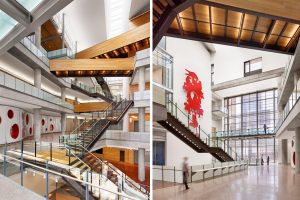My love of libraries began while attending the University of Texas at Austin, where I worked as a student aide at the Perry Castañeda Library, the main library on campus. For the past two years, I have worked full time as a Library Assistant at the Schaefer library, the newest public library branch in San Antonio, TX . Through these experiences, I’ve accrued a fair amount of library knowledge under my belt, having worked at an academic library and now a public library. However, since starting the Master’s in Public History program at St. Mary’s University, my perception of a library has changed. I had never really thought of a library as a type of museum before now. This semester, we have read a multitude of articles, books, and blogs and had many lively class discussions which has opened my eyes to the many similarities between museums and libraries. In this blog post I will identify some of these similarities:
The Collection
Arguably the most important aspects of a museum are the contents that fill the space. A traditional museum may contain historical artifacts, paintings, sculptures, mummies, dinosaur bones, and the list goes on and on. Science centers and children’s museums may not even have collections, but instead they may have rotating exhibitions or hands on activity stations. A common theme is that all institutions offer a rewarding experience for visitors. Similarly, libraries are repositories of knowledge, housing an assortment of books on all imaginable subjects; patrons can gain numerous skills by simply selecting the right book — car engine repair, GED study guide, cookbooks for diabetics, etc. In addition, libraries help bridge the digital divide by offering computer classes for beginners, coding workshops, and most notably, free and unlimited access to the internet. There are even online certification courses you can take to learn a myriad of skills ranging from conflict resolution to cake decorating, all free with a library card. The collections of both libraries and museums serve as community catalysts for positive change.
Collection Maintenance
In Library land, the process of acquiring items for the collection is similar to museums. All items must go through processing and assigned a barcode, as well as entered into an integrated library system, which is basically a digital platform to keep track of collections and patron accounts. The process of removing items from the collection in libraries is known as weeding. This process does not seem to carry the stigma that deaccessioning does for museums. Weeding items in libraries is a necessary part of maintaining the integrity of the collections. Working in a public library means serving the entire public, which often means a significantly shortened life span for the items in the collection. Just as we are continually repairing or weeding items, new items are also continually arriving. And so the cycle of life for the library collection continues.
Public Programs
My favorite aspect of working for the San Antonio Public Library is the wide variety of public programs I am able to plan, facilitate, or simply take part in. Public engagement through programming is a hugely important and vital service offered by libraries. Just like with museums, public programs are new ways to engage your public at all levels. Libraries offer weekly story times, teen programs, cooking classes, informational health workshops, and so much more. There are special events such as “Human Libraries” composed of people with varying life experiences where essentially patrons are able to “checkout” a human library book and have a conversation with an interesting stranger to learn more about their life. Libraries also work to extend their services through community outreach. The LA County library has a fleet of mobile makerspaces called MākMō, which are used to provide hands-on STEM education to all areas of the community.
Future of Libraries
And just as the future of museums is an uncertain one, with the need to evolve to a more visitor-centric approach, the future of libraries is constantly being debated. Not too long ago, I was asked by a woman if libraries still contain books, her assumption being that everything has been moved to a digital platform. The answer is yes we still have books, in case anyone is wondering. These types of questions are not uncommon as is the sentiment that libraries are a thing of the past. I believe that libraries are evolving, some quicker than others. A trend for relevant innovation is underway in the library community, as evidenced by many libraries worldwide. Collections are growing, adding more to their repertoire than the traditional books and movies. The Sacramento Public Library has tools and musical instruments available for checkout in the “Library of Things“. The architecture of libraries is also becoming more modern and aesthetically pleasing rather than the boxy look you see in a lot of older buildings, such as the new Austin Central Library, a model of stylish sustainability. The library I currently work at has an enormous public art piece for viewing as well as a record collection available for checkout.


I think the most promising change is the evolution to be more inclusive for all communities. Both libraries and museums are “unique in that they teach communities about the past and present, they provide resources for struggling families, refugees, and the LGBTQ community, and they preserve history“. Libraries and museums are community resources and are uniquely situated to tackle difficult social justice issues. These institutions are not extinct, but are instead in their next phase of evolution to become living cultural centers.

The idea of a Human Library is so cool– talk about a Public History connection! When i was little, my sister and I would spend forever inside our public library every day, and when we moved into a different house, my mother spent several weeks researching the house using the library’s collection. Super cool article, Sara!
Ahh, libraries. Ive always really enjoyed libraries so this was such a good read. I totally second Glory’s comment on the awesomeness of Human Libraries. What an awesome on the concept of communication. One of the reasons why I have always loved libraries is because I literally always learn something new when engaged with one (apparently in varies ways). Example. I totally didn’t know that the library offered certification classes! Thats so cool. Also, I wasn’t aware the book sales the library does was a result of weeding, I can’t even tell you how much of my book collection has come from weeding. And you’re right, libraries really are getting spiffy. A lot of the new ones are very architecturally impressive! Such a good read!!
You do s great job summarizing the appeal of libraries. I to have had a deep love of libraries since an early age. There is something tranquil about walking among the tall shelves of books. It is weird to go into a library and see how few books they have, but it is also nice to see them changing with the times. They have done a great job adapting to the technological world. It is nice to read about other people’s love for books and libraries.